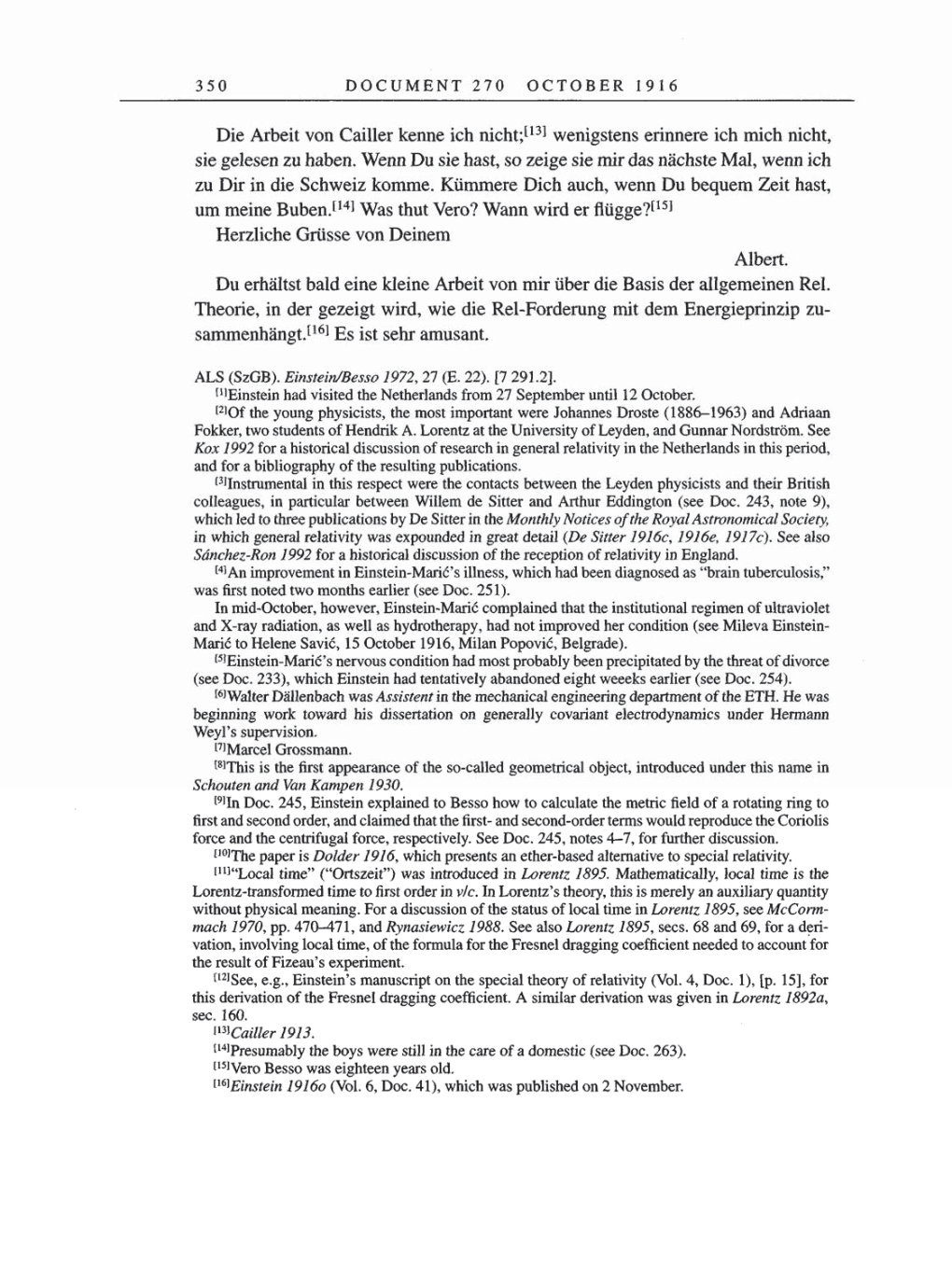350
DOCUMENT
270
OCTOBER 1916
Die Arbeit
von
Cailler
kenne ich
nicht;[13] wenigstens
erinnere ich mich
nicht,
sie
gelesen zu
haben. Wenn Du sie
hast,
so zeige
sie
mir
das nächste
Mal,
wenn
ich
zu
Dir in die Schweiz komme. Kümmere Dich
auch,
wenn
Du
bequem
Zeit
hast,
um
meine
Buben.[14]
Was
thut
Vero? Wann wird
er
flügge?[15]
Herzliche Grüsse
von
Deinem
Albert.
Du erhältst
bald
eine kleine Arbeit
von
mir über
die Basis der
allgemeinen
Rel.
Theorie,
in der
gezeigt wird,
wie die
Rel-Forderung
mit dem
Energieprinzip
zu-
sammenhängt.[16]
Es
ist
sehr amusant.
ALS
(SzGB).
Einstein/Besso
1972,
27
(E.
22).
[7 291.2].
[1]Einstein had visited
the
Netherlands from 27
September
until
12
October.
[2]Of
the
young
physicists,
the
most important
were
Johannes Droste
(1886-1963)
and Adriaan
Fokker,
two students
of
Hendrik A. Lorentz
at
the
University
of
Leyden,
and
Gunnar
Nordstrom. See
Kox 1992
for
a
historical discussion
of
research in
general relativity
in the Netherlands
in
this
period,
and
for
a bibliography
of
the
resulting
publications.
[3]Instrumental in this
respect
were
the contacts
between
the
Leyden
physicists
and their British
colleagues,
in
particular
between Willem de Sitter and
Arthur
Eddington
(see
Doc.
243,
note
9),
which led to three
publications by
De Sitter in the
Monthly
Notices
of the Royal
Astronomical
Society,
in which
general
relativity was
expounded
in
great
detail
(De
Sitter
1916c, 1916e, 1917c).
See also
Sánchez-Ron
1992
for
a
historical discussion
of
the
reception
of
relativity
in
England.
[4]An improvement
in Einstein-Maric’s
illness,
which
had been
diagnosed as
“brain
tuberculosis,”
was
first noted two
months
earlier
(see
Doc.
251).
In
mid-October, however,
Einstein-Maric
complained
that the institutional
regimen
of
ultraviolet
and
X-ray
radiation,
as
well
as hydrotherapy,
had not
improved
her
condition
(see
Mileva
Einstein-
Maric to Helene
Savic, 15
October
1916,
Milan
Popovic,
Belgrade).
[5]Einstein-Maric’s
nervous
condition had most
probably
been
precipitated by
the
threat of divorce
(see
Doc.
233),
which
Einstein
had
tentatively
abandoned
eight
weeeks
earlier
(see
Doc.
254).
[6]Walter
Dällenbach
was
Assistent in the
mechanical
engineering
department
of
the ETH. He
was
beginning
work
toward his
dissertation
on
generally covariant
electrodynamics
under
Hermann
Weyl’s supervision.
[7]Marcel Grossmann.
[8]This
is the first appearance
of
the so-called
geometrical object,
introduced
under
this
name
in
Schouten
and
Van Kampen
1930.
[9]In
Doc.
245,
Einstein
explained
to Besso how to calculate the metric field
of
a
rotating
ring
to
first and second
order,
and claimed that the first- and second-order terms would
reproduce
the Coriolis
force and
the
centrifugal
force,
respectively.
See Doc.
245,
notes 4-7,
for further
discussion.
[10]The paper
is
Dolder
1916,
which
presents an
ether-based alternative to
special relativity.
[11]"Local
time"
("Ortszeit")
was
introduced in Lorentz 1895.
Mathematically,
local time is the
Lorentz-transformed
time
to first order in v/c. In Lorentz’s
theory,
this is
merely an auxiliary quantity
without
physical meaning.
For
a
discussion
of
the status
of
local time in
Lorentz 1895,
see
McCorm-
mach
1970,
pp.
470-471, and
Rynasiewicz
1988. See also
Lorentz 1895,
secs.
68 and
69,
for
a
deri-
vation,
involving
local
time,
of
the formula for
the
Fresnel
dragging
coefficient needed to account for
the
result
of
Fizeau’s
experiment.
[12]See, e.g.,
Einstein’s
manuscript on
the
special theory
of
relativity
(Vol. 4,
Doc.
1),
[p.
15],
for
this derivation
of
the
Fresnel
dragging
coefficient. A similar derivation
was given
in
Lorentz 1892a,
sec. 160.
[13]Cailler
1913.
[14]Presumably
the
boys were
still in the
care
of
a
domestic
(see
Doc.
263).
[15]Vero
Besso
was
eighteen years
old.
[16]Einstein
1916o
(Vol.
6,
Doc.
41),
which
was
published
on
2 November.
